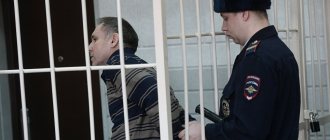Definition
Any murder, by definition, is a manifestation of cruelty towards the victim. However, in some cases, special attention is paid to the extent to which such cruelty was shown by the attacker. The Criminal Code of the Russian Federation does not provide a definition for such a feature, and therefore one should be guided by additional regulatory materials.
One of them is the resolution of the Plenum of the Supreme Court (PVS) of the Russian Federation No. 1, adopted in 1999. It is especially devoted to the analysis of the practice of courts considering cases relating to those murders that are provided for in Art. 105 of the Criminal Code of the Russian Federation.
Clause 8 of this act specifically addresses the issue regarding the intricacies of qualification under clause “e” of Part 2. The PVS indicates the following:
- Particular cruelty may be manifested both in the manner in which the death was caused and in other circumstances of the case.
- The killer's goal is to cause maximum suffering to the victim. In particular, this method is the use of torture, mockery of the victim, torture by hunger or thirst. As for moral suffering, the method can, in particular, be considered a case where the victim was killed in front of his loved ones.
- Abuse of a corpse cannot usually be considered as cruelty; Art. 244. However, if signs of a particularly painful murder are seen in other actions of the perpetrator, abuse of the corpse may also be one of the evidence that paragraph “e” of Art. 105 of the Criminal Code of the Russian Federation.
- Destruction (burning, use of acid or caustic alkali), as well as dismemberment of a corpse in order to get rid of traces of a crime cannot in itself be considered a sign of special cruelty.
Important: Although when making a decision, the judge should be guided only by the Criminal Code and the Code of Criminal Procedure of the Russian Federation, the position of the RF Supreme Court is extremely important, since it generalizes the existing practice - and as a result, law enforcers are guided by the opinion expressed by the RF Supreme Court.
Murder committed with extreme cruelty
The special cruelty of a murder should be understood as the special cruelty of the method of murder and its consequences (this includes a particularly painful way for the murdered person to commit the crime), and the special cruelty of the killer’s personality (his exceptional heartlessness, ruthlessness, ferocity, mercilessness), manifested in the crime committed.
It should be borne in mind that the establishment of particular cruelty is not within the competence of the forensic medical examination, since the concept of “cruelty” is not medical. This issue is resolved by the investigative and judicial authorities.
In its Resolution of the Plenum of the Supreme Court of the Russian Federation of January 27, 1999 No. 1 “On judicial practice in cases of murder (Article 105 of the Criminal Code of the Russian Federation)” in paragraph 8 indicated that when qualifying a murder under paragraph “d”, part 2 Art. 105 of the Criminal Code of the Russian Federation must be based on the fact that the concept of special cruelty is associated both with the method of murder and with other circumstances indicating the manifestation of special cruelty by the perpetrator. At the same time, in order to recognize a murder as committed with particular cruelty, it is necessary to establish that the intent of the perpetrator included committing the murder with particular cruelty.
A sign of special cruelty is present, in particular, in cases where, before the deprivation of life or in the process of committing a murder, the victim was subjected to torture, torture or mockery of the victim, or when the murder was committed in a way that the perpetrator knows is associated with causing special suffering to the victim (causing great number of bodily injuries, the use of painful poison, burning alive, prolonged deprivation of food, water, etc.).
At the same time, the multiplicity of injuries does not always indicate that a crime was committed with particular cruelty. As has already been said, in order to recognize a murder as committed with particular cruelty, it is necessary to establish that the perpetrator, inflicting many bodily injuries on the victim, was aware that he was causing him special torment and suffering.
Particular cruelty can be expressed in committing a murder in the presence of people close to the victim, when the perpetrator was aware that his actions were causing them special suffering.
Mockery of a corpse in itself cannot be regarded as a circumstance indicating the commission of a murder with particular cruelty. What was done in such cases, unless there is other evidence of the perpetrator showing particular cruelty before taking the victim’s life or in the process of committing a murder, should be qualified under the relevant part of Art. 105 and under Art. 244 of the Criminal Code of the Russian Federation, which provides for liability for desecration of the bodies of the dead.
The destruction or dismemberment of a corpse for the purpose of concealing a crime cannot be grounds for qualifying a murder as committed with particular cruelty.
However, in practice there is still no common understanding of these issues.
Moscow Regional Court Berezovsky S.N. was convicted under Part 2 of Art. 105 of the Criminal Code of the Russian Federation to 15 years in prison, with the first 10 years to be served in prison and the rest of the term in a general regime correctional colony.
By the verdict of the jury, Berezovsky was found guilty of being under the influence of alcohol on the territory of a car market located on the street on November 10, 2003, at about 9 p.m. **** in the city ****, in the building of the administration of the car market, in the rest room of the inspectors during a quarrel with T.V. Vasilyeva that arose on the basis of personal hostility. with the purpose of premeditated murder, he struck her with his hands in the face area and with a champagne bottle in the right temporal region. The victim lost consciousness from the blows. Berezovsky, believing that she was dead and wanting to get rid of Vasilyeva’s body, put it in the trunk of his Opel Cadet car and took it to the territory of the car market’s trading area, where, on the edge of the square adjacent to the bank of the Oka River, he took it out of the trunk. At that moment, the victim regained consciousness and began to call for help. Berezovsky, wanting to complete his criminal intent to kill, squeezed Vasilyeva’s neck with his hands and strangled her.
As a result of Berezovsky’s deliberate actions, Vasilyeva suffered life-threatening grievous bodily injuries in the form of: a closed craniocerebral injury resulting from repeated blows to the face in the frontal and right temporal region and indicated by multiple abrasions, bruises of the face, superficial bruised wounds of the right temporal areas with focal hemorrhages in the right temporal muscle, a crack in the internal bone grafting of the scales of the right temporal bone, focal hemorrhage under the pia mater of the left temporal lobe, cerebral vascular dystonia, edema of the brain substance.
Vasilyeva’s death occurred on the spot due to mechanical asphyxia from squeezing the neck organs with hands.
These actions were accompanied by bodily injuries in the form of multiple abrasions of irregular oval, crescent shape, anterior and anterolateral surfaces of the neck, multiple point and focal hemorrhages in the connective membrane of the eyes, a transverse fracture of the hyoid bone at the junction of the right greater horn with its body, with focal hemorrhage into the surrounding soft tissue, multiple pinpoint hemorrhages into the pulmonary tissue, focal ecphyserma and pulmonary edema, congestion of the internal organs, liquid state of the blood.
After Vasilyeva’s death, Berezovsky deliberately, showing particular cruelty, mocking the body of the deceased, exposed her and inflicted eight puncture wounds and cuts on the abdomen, chest, and genitals with the pocket knife he had.
The Cassation Chamber of the Supreme Court of the Russian Federation left the verdict unchanged.
In its ruling, the Cassation Chamber indicated that the court's conclusions about the guilt of the convicted person are based on the verdict of the jury, which is binding on the presiding judge. The specified requirement of the law in the present case has been met. There are no procedural violations leading to the reversal of the verdict in the case. They are not indicated in the cassation appeal either. At the trial, evidence obtained in compliance with the law was examined. The punishment for Berezovsky was assigned taking into account the nature and degree of public danger of the crime committed, information about the identity of the perpetrator and the verdict of the jury that he did not deserve leniency.
These court decisions were appealed by the defense in a supervisory procedure to the Supreme Court of the Russian Federation.
Supervisory complaint (extract)
By the verdict of the judicial panel for criminal cases of the Krasnodar Regional Court dated May 21, 1998, Sergey Nikolaevich Berezovsky was convicted under paragraph “d” of Part 2 of Art. 105 of the Criminal Code of the Russian Federation to 15 (fifteen) years of imprisonment with the first 10 (ten) years to be served in prison, and the remaining term of the sentence in a general regime scientific and technical commission.
By the ruling of the Cassation Chamber of the Supreme Court of the Russian Federation dated September 22, 1998, the verdict of the jury and the verdict of the Krasnodar Regional Court dated May 21, 1998 were left unchanged.
By the verdict of the jury and the verdict of the court, Berezovsky S.N. found guilty of premeditated murder of the victim Vasilyeva with particular cruelty.
I consider this sentence illegal and subject to change for the following reasons.
Qualifying Berezovsky’s actions as premeditated murder with particular cruelty, the court stated in the verdict that “after Vasilyeva’s death, Berezovsky deliberately, showing particular cruelty, mocking the body of the deceased, exposed her and with a pocket knife inflicted eight stab wounds and cuts to the abdomen, chest, genitals organs."
It is these actions of Berezovsky, as indicated in the verdict, that are subject to qualification under Art. 102 paragraph “g” of the Criminal Code of the RSFSR as intentional murder with particular cruelty.
However, such a conclusion of the court cannot be considered justified.
As the Plenum of the Supreme Court of the Russian Federation explained in paragraph 8 of Resolution No. 1 of January 27, 1999 “On judicial practice in murder cases,” mockery of a corpse in itself cannot be regarded as a circumstance indicating the commission of a murder with particular cruelty. What was done in such cases, unless there is other evidence of the perpetrator showing particular cruelty before taking the victim’s life or in the process of committing the murder, should be qualified as unqualified murder under Art. 244 of the Criminal Code of the Russian Federation, which provides for liability for desecration of the bodies of the dead.
As follows from the court verdict, other than mockery of the corpse, no other facts were established in the case that would indicate that Berezovsky not only had the goal of taking Vasilyeva’s life, but also cruelly torturing her before she was killed .
Having agreed with the arguments of the supervisory complaint, the Deputy Chairman of the Supreme Court of the Russian Federation filed a protest against the court decisions.
The protest stated that the court decisions taken in the case are subject to change on the following grounds.
The presiding judge indicated in the verdict that Berezovsky’s actions are subject to qualification under Art. 105 part 2 paragraph “d” of the Criminal Code of the Russian Federation as intentional murder with particular cruelty. The fact of mockery of the corpse, according to the court, is confirmed by the conclusion of the forensic medical examination, the protocol of the inspection of the scene of the incident and photographic tables for it.
Berezovsky himself, when he repented of his deeds, said that he mocked the body of the victim out of anger, in the form of revenge, with the goal of abusing the murdered woman. The fact that Berezovsky wanted to violate Vasilyeva, whom he killed, is confirmed by the nature of his actions: he cut off the nipples of the breast, cut the stomach, cut out the genitals, and left everything at the crime scene without trying to hide what he had done.
Thus, the verdict states that the particular cruelty of Berezovsky’s actions was expressed only in mockery of the victim’s corpse.
Meanwhile, according to the meaning of the law, a sign of special cruelty is present in cases where, before the deprivation of life or in the process of committing a murder, the victim was subjected to torture, torture or mockery of the victim, or when the murder was committed in a way that the perpetrator knows is associated with causing special suffering to the victim. Mockery of a corpse in itself cannot be regarded as a circumstance indicating the commission of a murder with particular cruelty.
In this case, the presiding judge did not provide any data in the verdict indicating that the victim was subjected to special suffering and torment before the deprivation of life or during the murder.
In the case, it was established that in the process of taking life, Berezovsky did not have any intention to cause special suffering to the victim. Consequently, he mocked not the victim of the crime, but the body of the deceased, and these actions cannot be qualified as a murder committed with particular cruelty. Under such circumstances, Berezovsky’s actions should be qualified under Art. 103 of the Criminal Code of the RSFSR (currently Art. 105 Part 1 of the Criminal Code of the Russian Federation).
When assigning punishment, one should take into account the nature and degree of public danger of the crime, personal data, as well as the fact that the jury found Berezovsky not worthy of leniency.
By a resolution of the Presidium of the Supreme Court of the Russian Federation, the protest was satisfied and Berezovsky's punishment was reduced from 15 to 10 years' imprisonment.
What is it characterized by?
Particular cruelty as a characteristic feature of this type of criminal action can manifest itself:
- Before causing death. This applies to situations where, before death, the victim is subjected to torture, bullying and other painful treatment by the criminal.
- Directly in the process - in the event that the attacker uses a method to cause death that causes the maximum amount of suffering to the victim.
- After death. Although the RF PVS determined that mockery of a body in itself is not a sign of this crime, if before this the attacker caused additional torture to the victim, then this becomes an additional sign of special cruelty.
In general, crimes of this kind are characterized by the fact that the perpetrator many times exceeds the measure of cruelty and torture necessary to simply take a person’s life. His goal is not just murder, but the most painful death of the victim.
However, those cases when the killer simply could not finish the job quickly and therefore, for example, stabbed the victim for a long time and ineptly with a knife, unsuccessfully strangled him, etc. cannot be considered as crimes committed with particular cruelty.
The main thing for qualification is precisely the purpose for which the criminal acted. If he was simply going to kill the victim, but for some reason could not do it quickly and relatively mercifully, there are no grounds for qualification under paragraph “d”, Part 1 of Art. 105 or another paragraph of Part 2.
About an aggravating circumstance
Cruelty as a factor influencing the victim can be divided into 3 parts:
- Infliction before committing murder.
- During its implementation.
- After the crime.
In addition, the following types of influence fall under the definition of special cruelty:
- death from painful shock, deprivation of water, poisoning, burning, etc.;
- psychological impact, including hostage holding and torture;
- torture before and during the murder;
- taking a person's life in front of other people.
Examples
An example of a murder committed with particular cruelty is a criminal case considered by the Voronezh Regional Court. Its plot is as follows: M. and N., who lived in one of the villages of the Nizhnedevitsky district of the Voronezh region, had long been in hostile relations. And one day M., with the intent to kill, sneaked into the territory of N.’s farm at night, stunned him and dragged him into the barn.
There M. tied N. with steel wire (so that he could not burn through the rope and free himself), waited until N. came to his senses, after which he locked the door and set the barn on fire.
A forensic psychiatric examination was ordered and carried out in the case. She admitted that M. was sane. As a result, he was sentenced to 12 years.
Another example where such a qualifying feature as “special cruelty” was applied unreasonably is a case considered by the same court several years later. The plot of the case: A. and K., living in a rural area, were drinking together one evening.
While drinking, they quarreled with each other, and A. called K. a goat. K., who was previously convicted, was in prison and adhered to the “thieves’ notions,” found this so offensive that he waited until the drunken A. fell asleep, after which he took an ax and chopped A. into pieces.
Initially, K.’s actions were qualified by the investigator under paragraph “e” of Part 2 of Art. 105 of the Criminal Code of the Russian Federation. However, later the defense was able to convincingly prove that by the time of dismemberment A. was already dead - the first blow hit the neck and separated the head. As a result, A.’s actions were reclassified under Part 1 of Art. 105.
The corpus delicti according to clause “D”, part 2 of Art. 105 of the Criminal Code of the Russian Federation
In relation to paragraph “d” of Art. 105 of the Criminal Code of the Russian Federation includes the following elements:
- The object is what the crime is aimed at. As elsewhere within the framework of Art. 105, the object is the life of a person who was killed.
- The objective side is how the criminal’s actions manifest themselves externally. Here such a manifestation would be causing death. For a crime to be considered completed, it is necessary that death occurs, and there is a direct cause-and-effect relationship between it and the actions of the perpetrator.
- Subject - a person who may be considered a criminal. According to Art. 20 of the Criminal Code of the Russian Federation, responsibility in this case begins at the age of 14 years. In addition, in order to be punished under criminal law, the attacker must be sane - that is, he must be aware of his actions and control them.
- The subjective side is how the attacker himself felt about the act he committed. As with any murder, the offender must act intentionally.
He must either directly wish for the death of the victim, or be indifferent to the consequences of his actions (this is possible if the main thing for the criminal is the torment of the victim, and whether he dies in the process does not bother him too much). However, the subjective side of this particular type of crime is characterized by the fact that the perpetrator realizes that by his actions he is causing unnecessary suffering to the victim.
Responsibility
Who is subject to
The subject of a crime is a sane individual who was 14 years old at the time of the commission of the unlawful act.
Particular cruelty as an aggravating circumstance
Particular cruelty is characterized not only by the methods of committing actions, but also by the time of their application.
- Before the murder. In this case, the perpetrator uses torture, torment, and psychological pressure against the victim.
- During torture, this is a method of committing murder in which a person experiences physical or mental suffering.
- After the murder. This aggravating circumstance applies only in cases where it is not the victim who suffers, but the witnesses to the incident.
Types of intent
Any murder according to modern Russian criminal law is an intentional crime.
In the event that the criminal did not intend to kill the victim, but only allowed her death, his actions will be qualified under other articles of the Criminal Code of the Russian Federation (for example, Article 109, which talks about careless deprivation of life, or Part 4 of Article 111, which provides for liability for grievous bodily harm resulting in death).
The crime provided for in paragraph “d” of Part 2 of Art. is no exception in terms of intent. 105 of the Criminal Code of the Russian Federation. It must also be intentional. However, this intention in practice can be of two types:
- Direct (Part 2 of Article 25 of the Criminal Code of the Russian Federation). In this case, the criminal wants to cause the victim a painful and cruel death, and his goal is precisely this. The attacker is fully aware that his actions are illegal, he knows about the possible consequences (in the form of the death of the victim) - and strives for exactly this.
- Indirect, also called eventual (Part 3 of Article 25 of the Criminal Code of the Russian Federation). In this case, the attacker’s goal is not to cause death, but he is aware of its possibility and even if he does not directly desire such consequences, he consciously allows them.
In relation to murder committed with particular cruelty, indirect intent is less common. It is difficult to say that a criminal who, by his actions (or inaction - if, for example, he forces the victim to die of hunger or thirst) causes additional suffering to the victim, does not want death to occur. However, such situations are theoretically possible. However, they will not affect the qualification of the act under paragraph “e” of Part 2 of Art. 105 of the Criminal Code of the Russian Federation.
Investigation and trial
The investigation of any case begins with establishing the method of committing the crime. In this particular case, it is first of all important to find evidence of the commission of an atrocity with particular cruelty. The operational and investigative team, together with employees of the forensic medical examination service, must determine the following points:
- time and cause of death;
- general circumstances of the case, including attempts by the killer to hide traces of the crime;
- identification of the person who committed the act;
- confirmation of the fact of causing death with particular cruelty;
- restoration of the identity of the murdered person and his characteristics;
- determining the purpose and motive for committing a given crime.
In order to obtain answers to all questions that arise, a set of measures is carried out to help solve these problems. Namely:
- Inspection of the crime scene.
- Forensic examination of the body.
- Search for material evidence and its examination.
- Interviewing witnesses.
- Interrogation of the person who committed the murder with particular cruelty.
When all the case materials have been collected, they are submitted to the court. The rest is at the discretion of the judge. He can either agree that the crime was committed with particular cruelty or refute this suspicion. Although now, thanks to amendments made to the legislation, everything has become transparent and obvious.
How many years of imprisonment are given as punishment?
Murder with particular cruelty is included as part of the second part of Art. 105. Consequently, it includes all types of punishments provided for in this part, which can be applied to the offender in the form of a measure of liability. Part 2 art. 105 of the Criminal Code of the Russian Federation provides for the following penalties for guilty persons:
- Imprisonment for a term of 8 to 20 years.
- Life sentence in a maximum security colony.
- The death penalty. This type of punishment has not actually been applied in Russia since April 1997, but formally it is still present in the Criminal Code of the Russian Federation.
If imprisonment for a certain period of time is used as a punishment, an additional restriction of freedom for a period of 1 to 2 years may be imposed. This type of punishment, provided for in Art. 53 of the Criminal Code of the Russian Federation, represents a prohibition for a convicted person to commit certain actions. In particular, the court may, for the duration of this sentence, prohibit him from:
- Leave your place of permanent residence.
- Do not visit places of mass events.
- Do not travel outside the municipal area.
- Do not change your place of work or study without the consent of the supervisory authority for those serving a sentence, etc.
In addition, in this case, the convicted person is obliged to appear for registration with the supervisory authority according to the established schedule (at least once a month).
General concept of murder
Murder is the intentional killing of another person. This definition is contained at the beginning of Art. 105 of the Criminal Code of the Russian Federation, and it best describes the essence of the criminal act.
For all other types of murders, which are not characterized by direct intent, there are separate articles in the Criminal Code of the Russian Federation. They relate to the regulation of murders due to negligence, in a state of passion, when the limits of necessary defense are exceeded.
Premeditated murder involves only one type of responsibility - actual imprisonment.
The amount of imprisonment will be determined based on the characteristics of the offense. For ordinary murder without aggravating circumstances, the convicted person will be sentenced to 6-15 years in prison.









